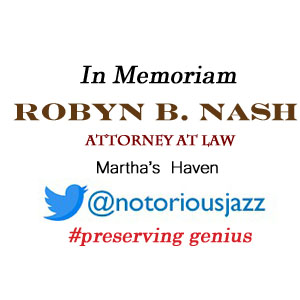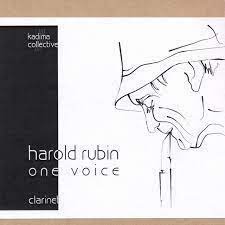
Daily Dose Of Jazz…
Harold Rubin was born on May 13, 1932 in Johannesburg, South Africa of Israeli descent. Attending Jeppe High School for Boys he received private instruction in the fine arts and classical clarinet as a teenager. He developed a fascination with jazz and began playing at the Skyline Night Club at eighteen. He went on to enroll as an architecture student at the University of the Witwatersrand and completed his professional studies in London, England.
Rubin’s creative endeavours in South African society during the 1950s and 1960s dissented against the apartheid-era Afrikaner establishment by defying the country’s racist social norms. Rubin organised his own jazz group in the 1950s, snuck into black townships, and played alongside black musicians.
Openly protesting the repressive political environment, Harold left the country for Israel, where he quickly established himself in Tel Aviv, and was employed as an architect and taught at an academy of architecture and design from the 1960s until his retirement in 1986. He returned to playing jazz in late 1979, having previously given up performance for more than a decade after his emigration from Africa. He became a founding member of the 1980s Zaviot Jazz Quartet, who throught he decade performed and recorded on Jazzis Records.
He was awarded the Landau Award in tribute to his contributions to jazz music in 2008, he continued to play jazz with musicians of the younger generations in Tel Aviv. Clarinetist Harold Rubin, who concentrated in the free jazz genre, transitioned on April 1, 2020 at the age of 87.
More Posts: bandleader,clarinet,history,instrumental,jazz,music
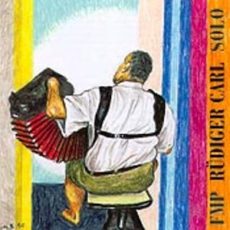
Daily Dose Of Jazz…
Rüdiger Carl was born on April 26, 1944 in Goldap, Poland ( formerly East Prussia) and has been involved in improvised music since 1968. He recorded his first record in 1972 and then began playing with a wide range of musicians including Arjen Gorter, Makaya Ntshoko, Louis Moholo, Maarten van Regteren Altena, Tristan Honsinger, Johnny Dyani and Han Bennink.
He maintains a long-standing partnership with Irene Schweizer that began in 1973 and continues to the present day. For a three year period, from 1973 to 1976 Carl was a member of Globe Unity Orchestra. He started giving solo performances in 1977 and the following year started two other long-term professional partnerships, with Sven-Åke Johansson and Hans Reichel.
Rüdiger’s most striking change in improvised music came when he gave up the saxophone and began performing with the accordion in duets with Hans Reichel. Though he continued to play the two instruments virtually side-by-side, adding clarinet to his arsenal, recorded Vorn which featured a version of the McCartney tune Those Were The Days. The COWWS Quintet was formed, continuing his musical relationship with Schweizer along with Philipp Wachsmann, Jay Oliver and Stephen Wittwer.
In addition to the COWWS, he performs with the Canvas Trio, in duos with Mayo Thompson of the Red Crayolas and Joëlle Léandre. During the Eighties he organized concerts of Musik im Portikus and beginning in 1994 has led the F.I.M. Orchester in Frankfurt/M.
Accordionist Rüdiger Carl is also an arranger and composer and continues to record and perform.
More Posts: accordion,arranger,bandleader,clarinet,composer,history,instrumental,jazz,music

Daily Dose Of Jazz…
Han Bennink was born April 17, 1942 in Zaandam, Netherlands, the son of a classical percussionist. He began playing the drums and the clarinet during his teens. He also went on to learn to play the violin, banjo and piano, which feature him on some of his recordings.
Through the 1960s, while in his t,wenties he was the drummer with a number of American musicians visiting the Netherlands, including Dexter Gordon, Wes Montgomery, Sonny Rollins and Eric Dolphy.
He subsequently became a central figure in the emerging European free improvisation scene. In 1963 he formed a quartet with pianist Misha Mengelberg and saxophonist Piet Noordijk which performed at the 1966 Newport Jazz Festival. The following year Han co-founded the Instant Composers Pool with Mengelberg and Willem Breuker, which sponsored Dutch avant garde performances. Late in the decade he played in a trio with saxophonist Peter Brötzmann and Belgian pianist Fred Van Hove, which became a duo after Van Hove’s departure in 1976.
From the late 1980s through the early 2000s, Bennik collaborated closely with Dutch post-punk band The Ex, simultaneously playing through the 1990s in Clusone 3, a trio with saxophonist/clarinetist Michael Moore and cellist Ernst Reijseger.
He has recorded twenty albums as a solo or leader and recorded over a eight dozen albums as a sideman with the likes of Derek Bailey, Conny Bauer, Don Cherry and Alexander von Schlippenbach, Steve Lacy, Lee Konitz, Ray anderson, Gary Bartz, Jckie McLean, Paul Bley, Annette Peacock, Anthony Braxton, Marion Brown, Uri Caine, Myra Melford, and Sonny Rollins. (partial list)
His style is wide-ranging, running from conventional jazz drumming to highly unconventional free improvisation. Drummer Han Bennink is best known as one of the pivotal figures in early European free jazz and free improvisation, and he continues to push forward the envelope of his music at 80.
More Posts: bandleader,banjo,clarinet,drums,history,instrumental,jazz,music,piano,violin
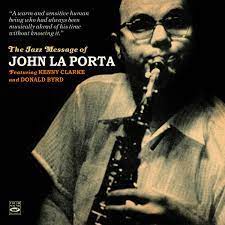
Daily Dose Of Jazz…
John Daniel LaPorta was born on April 13, 1920 in Philadelphia, Pennsylvania and started playing clarinet at the age of nine. He studied at the Mastbaum School in Philadelphia, alongside classmate Buddy DeFranco. As a teenager he played in local bands with Charlie Ventura and Bill Harris, and studied classically with Joseph Gigliotti of the Philadelphia Orchestra and Leon Russianoff at the Manhattan School of Music.
1942 saw him as a member of the Bob Chester big band for two years, then spent the following two years with the Woody Herman Orchestra. Beginning in 1947, he studied with Lennie Tristano, and with Teo Macero and Charles Mingus he was a member of the Jazz Composers Workshop, trying to combine jazz with classical music. Classically, he worked with Boston Pops, Leonard Bernstein, Leopold Stokowski, and Igor Stravinsky. In jazz he worked with Kenny Clarke, Miles Davis, Dizzy Gillespie, Charlie Parker, Buddy Rich, and Lester Young.
In 1956, La Porta played the first jazz concert in Venezuela at Caracas National Theater, where a selection of the repertoire performed was released under the title South American Brothers by Fantasy Records, becoming the first jazz recording in Venezuela.
As an educator he taught at Parkway Music School, then at public schools on Long Island, followed by the Manhattan School of Music and the Berklee College of Music. With guitarist Jack Petersen, he pioneered the use of Greek modes for teaching chord-scales.
In the 1990s, he retired to Sarasota, Florida, where he performed at the Sarasota Jazz Club and as a guest with the Fred Williams Trio. His autobiography is titled Playing It by Ear. Clarinetist and composer John LaPorta transitioned from complications of a stroke on May 12, 2004 in Sarasota.
More Posts: bandleader,clarinet,composer,history,instrumental,jazz,music
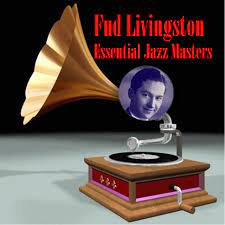
Daily Dose Of Jazz…
Joseph Anthony Livingston, better known by his peers as Fud, was born April 10, 1906 in Charleston, South Carolina and started out on accordion and piano before settling on saxophone. At seventeen he was playing with Tal Henry in Greensboro, North Carolina in 1923, then worked with Ben Pollack, the California Ramblers, Jean Goldkette, Nat Shilkret, Don Voorhees, and Jan Garber. He recorded freelance with musicians such as Joe Venuti, Red Nichols, and Miff Mole.
He did some arrangement work for Frankie Trumbauer and Bix Beiderbecke, including the nursery rhyme Humpty Dumpty. Livingston played on the 1928 Brunswick recording of “Room 1411” as a member of Bennie Goodman and His Boys, which also featured Glenn Miller, Jimmy McPartland, Bud Freeman, and Ben Pollack.
A stint in London,England in 1929 had him working with Fred Elizalde, then returned to New York City to play with Paul Whiteman. His time with Whiteman lasted from 1930 to 1933, and was mainly as an arranger, though he played occasionally. By the mid 1930s he worked with Benny Goodman, Jimmy Dorsey, Bob Zurke, and Pinky Tomlin as the country entered into the Forties. Essentially stopping his writing and arranging at this point, Fud would occasionally perform in small-time venues in New York in the 1950s.
His compositions included Feelin’ No Pain, Imagination, Humpty Dumpty, Harlem Twist, Sax Appeal, are well known but the jazz standard, I’m Thru With Love, written with Matty Malneck and Gus Kahn, has been recorded by over sixty musicians and vocalists, but a short list is Bing Crosby, Dizzy Gillespie, Arthur Prysock, Coleman Hawkins, Lorez Alexandria, John Pizzarelli, Joe Williams Marilyn Monroe, Maxine Sullivan and Steve Tyrell.
It has been sung in the films Everyone Says I Love You, Some Like It Hot, The Affairs Of Dobie Gillis and Spider~Man 3. Even Alfalfa from The Little Rascals had added it to his repertoire.
Clarinetist, saxophonist, arranger, and composer Fud Livingston, who never recorded as a leader, transitioned on March 25, 1957 in New York City.
More Posts: arranger,clarinet,composer,history,instrumental,jazz,music,saxophone



